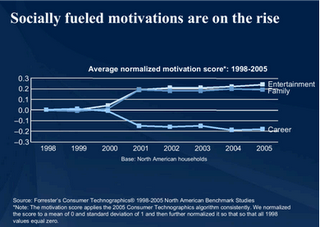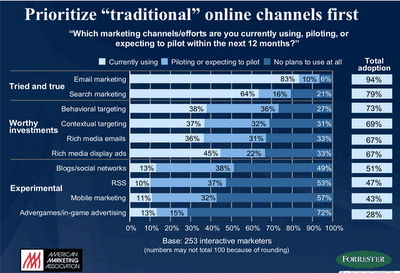This webcast focused on two topics: what Web 2.0 marketing vehicles are there and how to measure in a Web 2.0 environment.
Marketing
Shar VanBoskirk talked for most of the hour about marketing in a Web 2.0 way. I say "way" because it was more about how Web 2.0 represents a different philosophy rather than truely new methods. In this respect, the presenter focused on web efforts as facilitating people finding what they want and web tools as encouraging collaboration, especially collaboration. This
second point was taken to not be just collaboration between people, but also as collaboration between people and institutions (companies).
Both of these motivators were wrapped up in the concept of social computing. Shar defined social computing as "A social structure using technology to empower individuals and communities instead of institutions." Her talk seamed to be how to make institutions fit into this model. The Web 2.0 marketing efforts seemed to be that in-road.
 Most of the Web 2.0 efforts revolve around the growth of socialization on the internet, including a move away from standard interfaces to custom interfaces. A more "personal" web, if you will. Most Web 2.0 innovations (and new web innovation in general) seems geared toward pulling different pieces together in completely individualized ways. Often geared toward fun rather than work.
Most of the Web 2.0 efforts revolve around the growth of socialization on the internet, including a move away from standard interfaces to custom interfaces. A more "personal" web, if you will. Most Web 2.0 innovations (and new web innovation in general) seems geared toward pulling different pieces together in completely individualized ways. Often geared toward fun rather than work. And while this use of the web is still small, it is growing fast enough that marketers cannot ignore it.
And while this use of the web is still small, it is growing fast enough that marketers cannot ignore it.All Web 2.0 efforts seem to all qualify as "experimental". Some commonalities:
- Don't expect normal ROI
- Devote 10% of the marketing budget to experimental efforts
- Approach each as a sort of branding experiment rather than a sales effort.
- Try to use each to build relationships with consumers and make friends with them.
- Use Web 2.0 tools as a sort of bizdev tool
- Measure to find responses

Measurement
Akin Arikan talked for the last 15 minutes of the 60 minute webcast about measuring. Nothing surprising here. Web 2.0 needs an event based measurement model, as different from the current pageview based model. Because of this, more planning is needed in the project from the beginning. A brief overview:
Web 2.0 measurement should use cookies and logins to identify users. Cookies should be persistent so repeat visitors can be recognized (this concept of repeat visitors seems central to Web 2.0 efforts since it is used to denote a relationship).
Segment & measure in these ways:
- Use unique URLs
- Drive people to unique micro sites
- Offer unique telephone numbers
- Use unique buzzwords. then look for these buzzwords in tools such as Google Trends to see if buzz is developing around your slogans/unique phrases.
- Application level KPIs--overall usage. Includes traditional analytics and event-based analytics.
- Market level KPIs--meaning segment visitors into groups. Especially look for responses to messaging.
- Customer level KPIs--use individual customer behavior to drive individualized offers (permission based offers, etc.) and services then measure usage/adoption rate.


